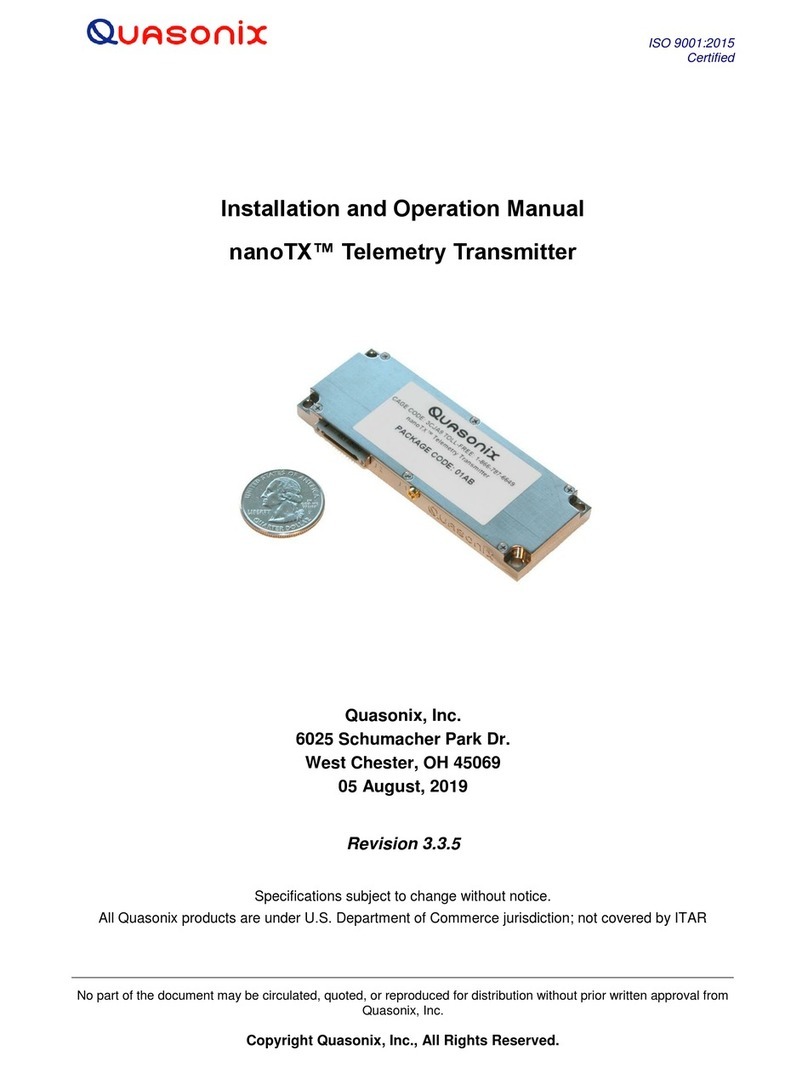
TIMTER™ Multi-mode Dual
Telemetry Transmitter
Figure 13: Pre-wired MDM-15 with 36” Pigtails for TTL.............................................................................. 19
Figure 14: MDM-15 Cable Harness for RS-422.......................................................................................... 19
Figure 15: MDM-15 Cable Harness for TTL................................................................................................ 20
Figure 16: Ruggedized Handheld Programmer .......................................................................................... 20
Figure 17: USB to Serial Converter Cable .................................................................................................. 21
Figure 18: Switch Box with 18” MDM-9 to MDM-9 Cable Harness............................................................. 21
Figure 19: 7.2 in3 TIMTER™ Dual Transmitter .......................................................................................... 22
Figure 20: Dual Transmitter RF Outputs..................................................................................................... 22
Figure 21: Dual Transmitter RF Outputs Connected to Upper and Lower Antenna ................................... 23
Figure 22: Dual Transmitter RF Outputs Connected to Upper and Lower Antenna Transmitting to
Receiver in STC Mode ................................................................................................................................ 24
Figure 23: Outline Drawing, TIMTER™ Dual Transmitter, 07AH Package, S-band Female MDM-15....... 25
Figure 24: Outline Drawing, TIMTER™ Dual Transmitter, 07AN Package, S-band Male MDM-15........... 26
Figure 25: 24.0 in3 TIMTER™ Dual Transmitter ........................................................................................ 27
Figure 26: Outline Drawing, TIMTER™ Dual Transmitter, 24AA Package, Male MDM-15........................ 28
Figure 27: MDM-15 Female Pin Numbering, RS-422 Interface –07AH Package...................................... 30
Figure 28: MDM-15 Male Pin Numbering, TTL Interface –09AM Package ............................................... 30
Figure 29: Baseband Signal Timing............................................................................................................ 31
Figure 30: TIMTER™ Welcome Message .................................................................................................. 33
Figure 31: PCM/FM (Tier 0) Power Spectral Density with Mask ................................................................ 85
Figure 32: SOQPSK-TG (Tier I) Power Spectral Density with Mask .......................................................... 85
Figure 33: MULTI-h CPM (Tier II) Power Spectral Density with Mask ....................................................... 86
Figure 34: Phase Noise Limit Curve ........................................................................................................... 87
Figure 35: Vibration / Shock Testing System.............................................................................................. 88
Figure 36: TIMTER™ Mounted for Z-axis Testing ...................................................................................... 88
Figure 37: TIMTER™ Mounted for X-axis Testing...................................................................................... 89
Figure 38: TIMTER™ Mounted for Y-axis Testing...................................................................................... 89
Figure 39: TIMTER™ Vibration Profile ....................................................................................................... 89
Figure 40: Z-axis Vibration Spectrum ......................................................................................................... 90
Figure 41: Y-axis Vibration Spectrum ......................................................................................................... 91
Figure 42: X-axis Vibration Spectrum ......................................................................................................... 91
Figure 43: Shock Pulse, Z-axis Positive ..................................................................................................... 92
Figure 44: Shock Pulse, Z-axis Negative.................................................................................................... 93
Figure 45: Shock Pulse, Y-axis Positive ..................................................................................................... 93
Figure 46: Shock Pulse, Y-axis Negative.................................................................................................... 94
Figure 47: Shock Pulse, X-axis Positive ..................................................................................................... 94
Figure 48: Shock Pulse, X-axis Negative.................................................................................................... 95





























